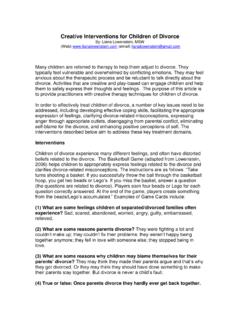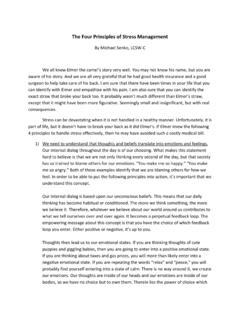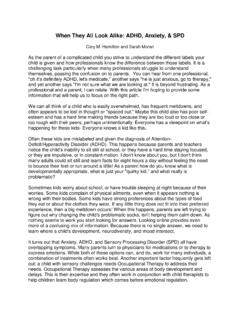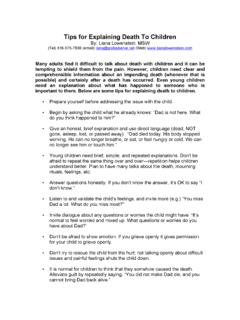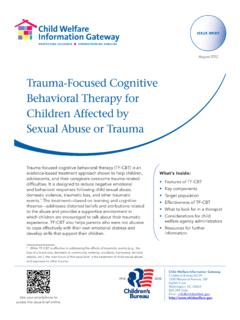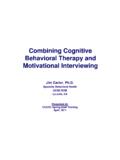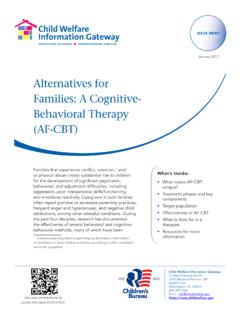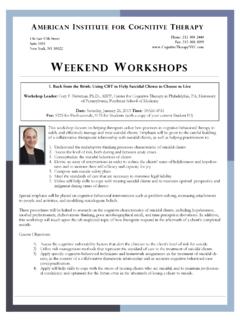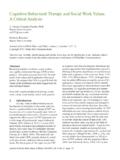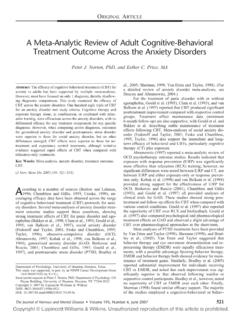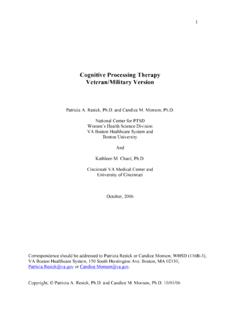Transcription of Playful Trauma Focused-Cognitive Behavioral …
1 1 Playful TFCBT Angela , Playful Trauma Focused-Cognitive Behavioral therapy With Traumatized Children Angela M. Cavett, , , RPT-S Trauma Focused-Cognitive Behavioral therapy (TF-CBT) has been identified as a treatment with the greatest empirical support for use with traumatized children. The model was developed by Cohen, Deblinger, and Mannarino (2006) to integrate research-based programs developed to address what was found to be effective in reducing symptoms in children following sexual abuse. The model was later expanded to other traumas (traumatic grief, terror, physical abuse, life threatening illness, disaster) as well. Each of the factors seen as necessary for healing was developed into the components of TF-CBT. The components of TFCBT are: Psychoeducation and Parenting skills, Relaxation, Affective modulation, cognitive coping/processing, Trauma narrative, In vivo mastery, Conjoint child-parent sessions, Enhancing future safety (Cohen, Mannarino, Deblinger, 2006) Although clinical judgment is considered crucial in deciding the extent to which and how a component is utilized, the components with the exception of In Vivo Exposures are typically necessary in therapy .
2 The components were developed to address what is thought to be important in healing traumatized children; there is flexibility to address each component in the manner most helpful for the individual client. Often play interventions allow for a developmentally appropriate and engaging approach to children. Any child who would 2 Playful TFCBT Angela , benefit from TF-CBT would benefit from the clinician utilizing play therapy interventions consistent with the components of TF-CBT administered in accordance with the TF-CBT treatment model. TF-CBT begins with assessment which is essential in evaluating the symptom constellation for a child. The therapist utilizes assessment instruments ( , Child Behavior Checklist) to assess problem areas and communicates this with the parent and child.
3 The treatment plan can be made concrete to the child by using play therapy interventions. For example, the parent and child can utilize the Caterpillar to Butterfly technique to engage in the treatment plan development. This is an art/play project created by the child and parent. A caterpillar is created by the parent and child in the session with pipe cleaners and other art supplies. They also use foam sheets, markers and pipe cleaners to create butterflies. They list several ( , four) problems/symptoms that they would like to address in therapy . After the caterpillar and butterfly are created, several ( , four) problems/symptoms are listed under the title caterpillar and the corresponding goals are listed below the title butterfly. Another Playful way to utilize the assessment information and develop a treatment plan at the outset of TF-CBT is to utilize Goodyear-Brown s Step by Step intervention (2005).
4 Psychoeducation is the first component of TF-CBT and is utilized throughout the treatment. Play interventions are helpful to teach the child about Trauma . A Playful manner to address this is to use bibliotherapy (read the child a book related to the Trauma ). The child can act out the story with puppets or figurines. The second component of TF-CBT is related to parenting. Utilizing the TF-CBT model, the therapist addresses parenting skills through teaching Behavioral interventions 3 Playful TFCBT Angela , such as praise and contingency plans/behavior modification. This component can be initiated by the therapist by using the Me and my Mom Technique (Crisci, Lay, & Lowenstein, 1998) which makes apparent the changes that have occurred in the parent-child relationship due to the Trauma .
5 Relaxation is the third component of TF-CBT and is helpful in teaching the skills related to reducing anxiety. Breathing interventions and progressive muscle relaxation are commonly used. A breathing intervention that is powerful for children is Four-Square Breathing. The child draws a square and labels the corners 1. Breathe in, 2. Hold it, 3. Breathe out, and 4. Do nothing. The therapist also discusses, at the developmentally-appropriate level for that child, a square has four sides and each step can be done for four seconds each and practiced four times a day. The four-seconds allow for adequate deep inhalation and exhalation as well as a visual and auditory cue for remembering the intervention. The third step is practiced with bubbles as a visual of adequate exhalation.
6 The therapist playfully does short, angry breaths that produce few if any bubbles and long, relaxed breaths as they demonstrate bubble-making. The child is praised for long, relaxed breaths that result in big or numerous bubbles. A second intervention related to relaxation is using Four-Square breathing with a flat stuffed animal on the diaphragm to visually depict inhalation and exhalation. Play therapy techniques can be used to teach the child progressive muscle relaxation. The child is taught that muscles can be tight or relaxed. This can initiated by providing a hard ( , superhero action figure) and soft toy ( floppy ragdoll) for the child to touch while the therapist discusses how hard/soft each is. PMR can be individualized and relabeled depending on the hard and soft toys the child uses ( , 4 Playful TFCBT Angela , Mark s Superhero/bear game).
7 The child and therapist can dance/march a stiff, hard muscle dance followed by flopping dance. The dance is followed by progressively tightening and relaxing muscles as in standard PMR. Play interventions addressing the component of Affective Expression and Modulation are abundant. It is helpful to address identification of feelings in self and others, measurement and expression of the intensity of the feeling and expression of the feelings. First children are taught a range of feelings depending upon their developmental level. Although standard TF-CBT suggests handouts or charades for feelings identification, it is more engaging to have a broad array of play interventions to best engage each individual child. Feelings Tic-Tac-Toe (Lowenstein, 1999) is an engaging game.
8 Feelings puzzles such as puzzles of bears with several heads depicting different emotions and toys such as the Meebie (a plush toy with Velcro facial features) allow for play during the discussion of feelings. Paris Goodyear-Brown suggests several interventions that allow for discussion of feelings such as Mood Manicure (2002) which allows the child to pick colors of fingernail polish to represent different moods which are discussed as the therapist paints the child s nails. The measurement and expression of the intensity of emotions can be addressed with several play therapy techniques. For example, the degree of feelings can be depicted using beads on an abacus. Mad Maracas (Goodyear-Brown, 2005) is an intervention which depicts intensity of affect through the shaking of maracas.
9 The Parachute Feelings-Ometer intervention (Cavett, 2009) utilizes a parachute and balls to depict the intensity of feelings. The expression of feelings can be discussed with Playful interventions such as Anger Menu (Cavett, in press). 5 Playful TFCBT Angela , The next component in TF-CBT is discussion about the cognitive Triangle. During this discussion the child is taught about the connection between feelings, thoughts and behaviors. The How I Think, Feel and Behave activity (Lowenstein, 2006) was developed to address responses to death and can be utilized to process traumatic grief. The therapist can also utilize the statements in the intervention to address the thinking, feeling and behavior of children with other traumas. The Acting on my Feelings technique (Crisi, Lay, & Lowenstein, 1998) also addresses the link in a developmentally appropriate manner.
10 The component that has been described as the most important by children and their parents when assessing the effectiveness of TF-CBT is the creation of the Trauma Narrative and the processing thereof (Cohen, Mannarino, & Deblinger, 2006). The Trauma narrative is developed in therapy over many sessions. The telling of the traumatic experience (creating the narrative) can be done with the child playing out the Trauma while dictating to the therapist the Trauma narrative. For example, the child may act the Trauma out in the doll house with figures. At times, children are able to give additional details when they play out the Trauma narrative with the dolls/house that were not in their first verbal telling of the narrative. After the Trauma narrative is developed, it is processed at which time psychoeducation addresses responses and normalization of the child s reactions.
